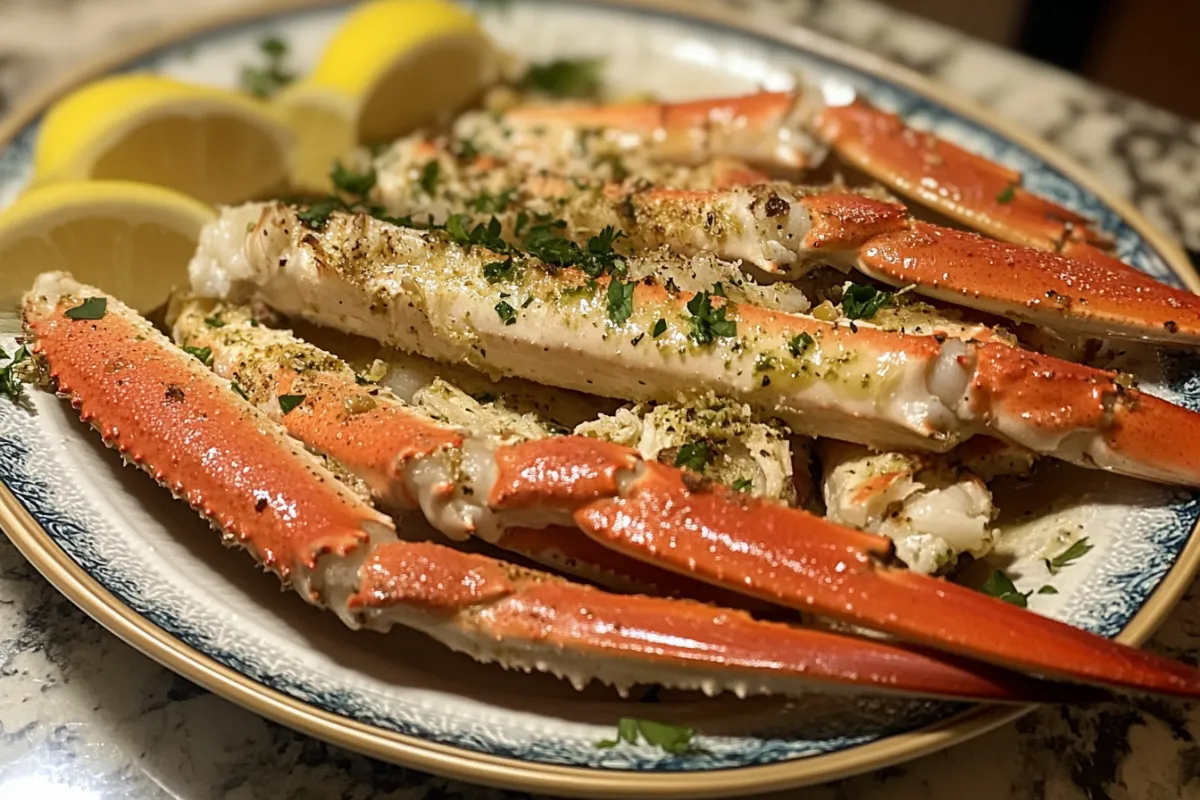Ultimate Guide to Crab Legs: Everything You Need to Know
Crab is a celebrated seafood delicacy, offering rich, succulent meat enjoyed by people all over the world. Whether you’re indulging in King Crab at a high-end restaurant or preparing Snow Crab at home, this seafood never fails to satisfy. In this comprehensive guide, we’ll explore all there is to know about this popular crustacean, from anatomy and nutritional value to serving size recommendations, cooking methods, and sustainability practices.
Crabs, particularly species like King, Snow, and Dungeness, are harvested for their tender, flavorful meat. Each of these species offers its own unique taste and texture. Whether you’re looking to buy, cook, or serve crab for a meal, this guide will provide you with all the essential details.
Part 1: Crab Anatomy and How Many Legs Do Crabs Have?
What Are Crab Legs?
Crab limbs are known for containing sweet, tender meat, making them a popular seafood choice. These limbs come from various species, each offering distinct flavors and textures. Crabs belong to the decapod family, meaning they have ten limbs — eight for walking and two claws for catching prey and defense. It’s in the legs and claws that the majority of edible meat is found.
Species such as King, Snow, and Dungeness Crabs are prized for the meat in their limbs. While all crabs share similar anatomy, the size and meat yield vary significantly between species.
External Resource: For more details on crab anatomy, visit National Geographic’s guide to crabs.
How Many Legs Do Crabs Have?
Crabs are decapods, meaning they have ten limbs: eight walking legs and two claws. Although the number of limbs is the same across all crab species, their size, thickness, and meat content can vary.
For instance:
- King Crabs have long, thick limbs, with each one often weighing over a pound.
- Snow Crabs have thinner, more delicate legs but still offer plenty of meat.
- Dungeness Crabs are smaller, but their shorter legs deliver a lot of sweet, flavorful meat.
Though each species differs, all crabs follow the same basic structure of ten limbs.
Popular Species for Their Legs
Three species are especially popular for their edible limbs:
- King Crab: Famous for its enormous size, King Crab provides rich, buttery meat and is considered a delicacy.
- Snow Crab: With long, slender limbs, Snow Crab is more affordable and widely available.
- Dungeness Crab: Known for its tender, sweet meat, Dungeness is a West Coast favorite.
Each species brings unique flavors and textures to the table, making them highly sought-after in seafood dishes.
Part 2: How Much Crab to Serve?
How Many Crab Legs in a Pound?
The number of limbs per pound varies between species, and knowing this can help when planning a meal.
- King Crabs: Due to their size, expect 1 to 2 legs per pound. These legs are packed with substantial amounts of meat.
- Snow Crabs: Smaller and thinner, Snow Crab legs come in clusters of 4 to 6 per pound.
- Dungeness Crabs: You’ll usually get around 2 to 3 legs per pound of Dungeness Crab, though they are often sold whole.
Understanding these differences will help you plan how much to purchase for any occasion.
Meat Yield Per Serving
Knowing the meat yield per serving is essential when planning meals. Here’s what you can expect from each species:
- King Crab: Around 0.7 to 0.8 pounds of meat per pound of limbs.
- Snow Crab: Roughly 0.5 pounds of meat per pound.
- Dungeness Crab: About 0.4 to 0.5 pounds of meat per pound.
King Crab provides the most meat per leg, but Snow and Dungeness varieties are just as delicious and easier to find.
Part 3: How Much to Serve Per Person?
Serving Size Recommendations
When preparing this type of seafood, it’s important to plan the right portion sizes for your guests. General guidelines are as follows:
- For King Crab: 1 to 1.5 pounds per person for a main course, as these legs are larger and contain more meat.
- For Snow Crab: 1.5 to 2 pounds per person, due to their smaller size.
- For Dungeness Crab: Serve 2 to 3 pounds of whole crab or legs per person. The smaller size means you’ll need more to satisfy your guests.
If serving the crab as part of a larger meal or buffet, you can adjust to 0.5 to 1 pound per person.
Internal Link Opportunity: For additional tips on portion control, check out our post on how much batter to use in cakes, which offers helpful serving size guidelines for various dishes.
Part 4: Cooking Methods
Boiling
Boiling is a quick and easy way to prepare crab, ensuring the meat stays moist and tender.
Steps to Boil Crab:
- Fill a large pot with enough water to cover the meat. Add salt or seasoning for flavor.
- Bring the water to a rolling boil.
- Add the crab pieces and cook for 4 to 6 minutes if fresh, or 8 to 10 minutes if frozen.
- Remove the crab and drain.
Boiling works well for both fresh and frozen crab and pairs perfectly with garlic butter or lemon wedges.
Steaming
Steaming is an excellent way to preserve the crab’s natural sweetness and ensure a firm texture.
Steps to Steam Crab:
- Fill a pot with 2 to 3 inches of water and place a steamer basket inside.
- Bring the water to a boil.
- Place the crab inside the basket and cover.
- Steam for 5 to 7 minutes.
Steaming is ideal for those who prefer a clean, natural taste, as it retains the pure flavors of the meat.
Grilling
Grilling adds a unique, smoky flavor to crab, making it a fun and flavorful way to prepare seafood.
Steps to Grill Crab:
- Preheat the grill to medium-high heat.
- Brush the crab pieces with olive oil or butter to prevent sticking.
- Place the crab on the grill and cook for 5 to 7 minutes, turning occasionally.
- Serve with garlic butter or lemon wedges.
Grilling adds depth to the natural sweetness and works wonderfully for outdoor gatherings or cookouts.
Internal Link Opportunity: For more grilling ideas, check out our post on grilling seafood, which provides tips for preparing seafood on the grill.
Part 5: Nutritional Benefits
High in Protein
Crab meat is an excellent source of lean protein, providing about 18-20 grams per 3-ounce serving. Protein is essential for muscle growth and repair, making this seafood a great option for those seeking to boost their protein intake.
Low in Calories and Fat
Crab meat is low in calories and fat, particularly saturated fat, which makes it a heart-healthy option. A 3-ounce serving contains just 82 calories, perfect for those maintaining a healthy weight.
Rich in Omega-3 Fatty Acids
Crab contains omega-3 fatty acids, which are known for their heart-health benefits. These fatty acids help reduce inflammation and lower cholesterol levels, promoting overall cardiovascular health.
Packed with Vitamins and Minerals
Crab meat is a great source of essential vitamins and minerals, including:
- Vitamin B12: Supports nerve health and DNA production.
- Zinc: Boosts the immune system.
- Selenium: Acts as a powerful antioxidant.
By including crab in your diet, you’re benefiting from a wide range of nutrients that support overall health.
Part 6: Sustainability and Ethical Considerations
Choosing Sustainable Seafood
With the growing demand for seafood, it’s important to ensure that your crab is sourced sustainably. Overfishing can lead to declining crab populations and damage to marine ecosystems. Look for products with the Marine Stewardship Council (MSC) certification to guarantee sustainable fishing practices.
Choosing sustainably sourced seafood helps protect the marine environment for future generations.
Ethical Harvesting Practices
Trap fishing is a common method for catching crab, but it can sometimes result in bycatch, which impacts other marine species. Support fisheries that use ethical practices to minimize harm to the ecosystem.
Part 7: Frequently Asked Questions (FAQs)
- How many legs does a crab have?
- Crabs have ten limbs: eight walking legs and two claws.
- How many crab legs are in a pound?
- It varies by species. King Crabs yield 1 to 2 legs per pound, while Snow Crabs offer 4 to 6 legs per pound.
- How much crab should I buy per person?
- Plan for 1 to 1.5 pounds of King Crab or 1.5 to 2 pounds of Snow Crab per person for a main course.
- What’s the best way to cook crab legs?
- Boiling, steaming, and grilling are all excellent methods, taking about 5 to 7 minutes to cook thoroughly.
- Are crab legs healthy?
- Yes, crab is high in protein, low in fat and calories, and rich in omega-3s, vitamins, and minerals.
Conclusion
Crab is a versatile, nutritious, and delicious seafood option that can be enjoyed in many ways. Whether you’re preparing King Crab for a special dinner or grilling Snow Crab for a casual summer meal, this guide provides everything you need to make the most of your seafood experience.
By understanding how to cook, serve, and enjoy crab responsibly, you can create meals that are both flavorful and sustainable. Don’t forget to choose responsibly sourced products to ensure that future generations can enjoy the bounty of the sea.
External Resource: For more information on sustainable seafood, visit NOAA Fisheries.


1 thought on “Crab Legs: Types, Cooking Tips, and Serving Sizes”